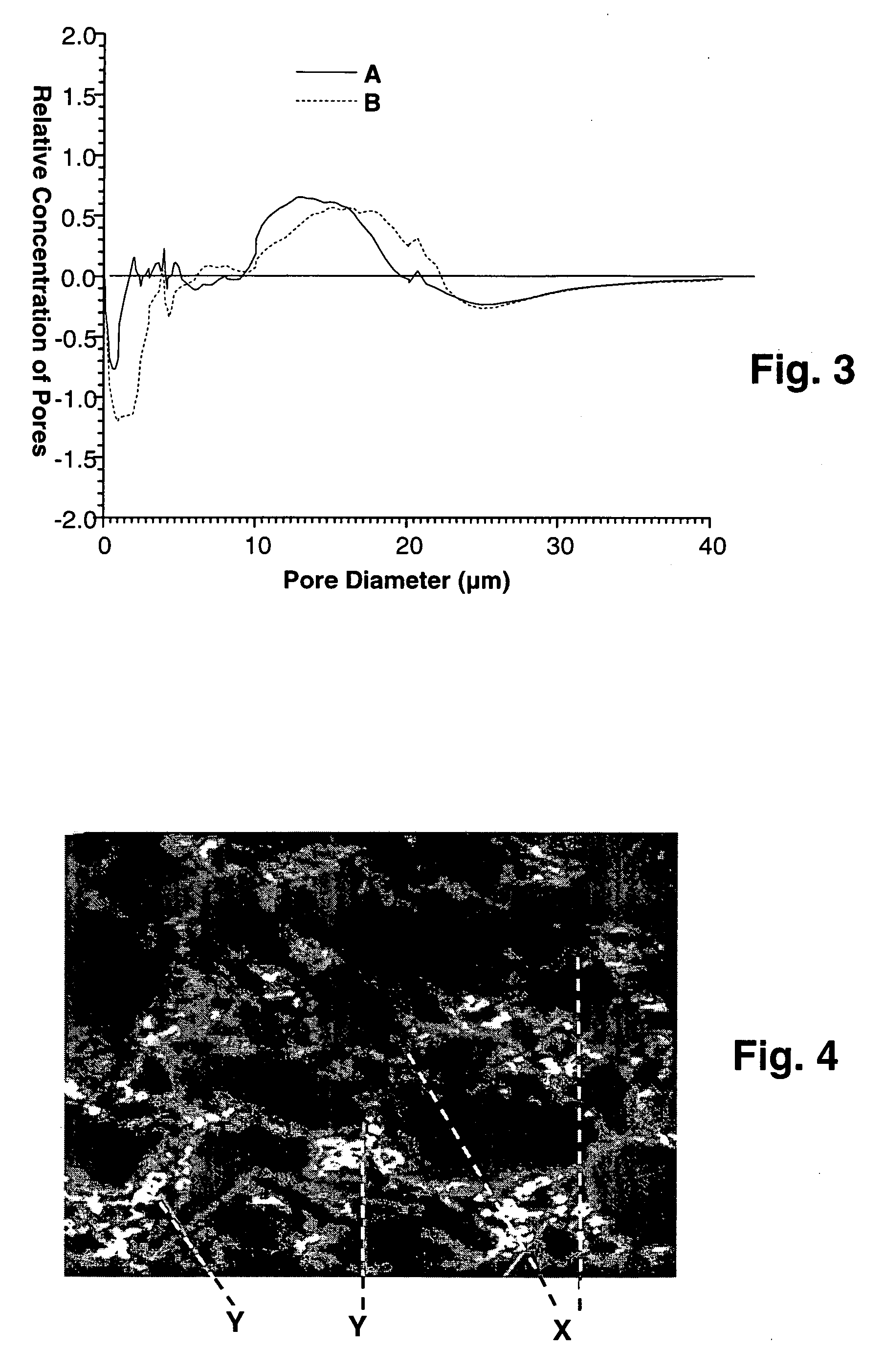Porous ceramic filters with catalyst coatings
a technology of ceramic substrates and catalysts, applied in catalyst activation/preparation, metal/metal-oxide/metal-hydroxide catalysts, chemical/physical processes, etc., can solve the problems of increasing thermal expansion, reducing gas permeability, and the problem is the most severe, so as to reduce pressure drop, reduce pressure drop, and extensive cross-linking of polymers
- Summary
- Abstract
- Description
- Claims
- Application Information
AI Technical Summary
Benefits of technology
Problems solved by technology
Method used
Image
Examples
example 1
[0039] Cross-linkable polymer solutions are prepared following one of two procedures. In a first procedure, 4.0 g of 70% (weight) hexamethylenediamine solution and 7.5 g of 99% (weight) epichlorohydrin are mixed into 2500 ml samples of three ionene polymer solutions. The polymer solutions are solutions of 1.5% (weight), 3% (weight), and 6% (weight) polymer concentration, being made up in each case by an appropriate water dilution of a commercial ionene polymer preparation. The commercial preparation is PC-1195™ polymer solution, sold by GE Betz, GE Water Technologies, Trevose, Pa., U.S.A. and containing about 40-50% by weight of dissolved amine-functional ionene polymer solids having a molecular weight of about 170,000. The three cross-linkable polymer solutions thus provided are allowed to age for five days prior to use.
[0040] In a second procedure, a 3450 ml sample of a 12% (weight) PC-1195™ ionene solution is mixed with 30.0 g of a 70% (weight) hexamethylenediamine solution and ...
example 2
[0048] Following the procedure of Example 1 above, several additional aluminum titanate ceramic samples similar in composition to the filter samples of Example 1, but having a lower average linear coefficient of thermal expansion (CTE) of about 4.7×10−7 / ° C. over the 25-1000° C. temperature range, are polymer-coated and washcoated as described in that Example. The washcoated samples are then tested for the extent of CTE increase, with the results reported in Table 2 below.
TABLE 2Barrier-Coated Aluminum Titanate Honeycomb SamplesCross-BareCrosslinkableLinkedSam-SamplePolymerPolymerWashcoatpleWeightSolutionCoatingWeightCTENo.(g)ConcentrationWeight (%)(g / L)(×10−7 / ° C.)6-133.932 6.0% wt1.0338.98.86-224.506 9.0% wt1.6141.37.96-336.08912.0% wt2.1240.24.8
[0049] As the data reported in Table 2 suggest, ceramic honeycomb samples coated with cross-linkable ionene polymer solutions of increasing concentration show decreasing levels of thermal expansion change resulting from the washcoating p...
example 3
[0051] A number of ceramic coating samples are prepared from a cordierite ceramic honeycomb stock, the samples being alternately plugged at opposite ends to provide small honeycomb filter samples. The cordierite honeycombs have a cell density of about 31 cells / cm2, a channel wall thickness of about 300 micrometers, and an average linear coefficient of thermal expansion (25-1000° C.) of about 8×10−7 / ° C.
[0052] Each filter sample is coated with a selected cross-linkable ionene polymer coating from one of the ionene polymer solutions above described, and is then heated to remove water and cross-link the polymer as described in Example 1. The samples are then washcoated with the alumina suspension as described in Example 1, except that the commercial Nyacol® AL20 alumina washcoating suspension was first water-diluted to a pH of 3.5 prior to use. Finally the suspension-coated samples are heated to set the washcoat and pyrolize the polymer coating.
[0053] Table 3 below presents data resu...
PUM
| Property | Measurement | Unit |
|---|---|---|
| temperature | aaaaa | aaaaa |
| temperature | aaaaa | aaaaa |
| crack widths | aaaaa | aaaaa |
Abstract
Description
Claims
Application Information
 Login to View More
Login to View More - R&D
- Intellectual Property
- Life Sciences
- Materials
- Tech Scout
- Unparalleled Data Quality
- Higher Quality Content
- 60% Fewer Hallucinations
Browse by: Latest US Patents, China's latest patents, Technical Efficacy Thesaurus, Application Domain, Technology Topic, Popular Technical Reports.
© 2025 PatSnap. All rights reserved.Legal|Privacy policy|Modern Slavery Act Transparency Statement|Sitemap|About US| Contact US: help@patsnap.com



